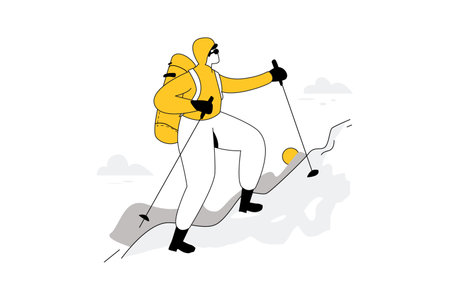Understanding Outdoor Choking and Breathing Hazards in the UK
When venturing outdoors in the UK, whether for a countryside walk, a coastal hike, or a woodland adventure, it is crucial to be aware of the specific choking and breathing hazards that may arise. The unique British landscape—marked by its rugged hills, dense forests, and variable weather—presents certain risks not always encountered in other environments. Common causes of choking during outdoor activities include eating on the move, particularly when consuming picnic foods such as sandwiches, crisps, or fruit; these can easily become lodged in the throat if not chewed thoroughly or if eaten while distracted by the surroundings. In terms of breathing emergencies, seasonal factors play a significant role. Spring and summer bring an increase in pollen levels, which can trigger asthma attacks or severe allergic reactions among sensitive individuals. Additionally, sudden drops in temperature or unexpected rainfall—both frequent occurrences in the UK—can exacerbate pre-existing respiratory conditions or cause hypothermia-related breathing difficulties. Unique local risks also stem from the presence of stinging insects like wasps and bees, whose stings may induce life-threatening anaphylaxis. Moreover, remote settings often delay emergency response times, making immediate and knowledgeable action even more vital. Understanding these region-specific factors equips outdoor leaders and participants with the awareness needed to mitigate risks and respond effectively should a choking or breathing emergency occur.
2. Recognising the Signs of Choking and Respiratory Distress
When outdoors in the UK, prompt identification of choking or respiratory distress is crucial for effective intervention. British first aid guidelines emphasise the importance of observing both visible and audible cues to determine if someone is in danger. Responders must stay calm and act decisively, especially as outdoor environments often present additional challenges such as wind, noise, or limited visibility.
Key Indicators of Choking
Recognising choking involves understanding the difference between mild and severe airway obstruction. The following table outlines the primary signs according to UK first aid standards:
| Type | Key Signs | First Aid Response |
|---|---|---|
| Mild Obstruction | Coughing forcefully, able to speak or breathe, may grasp throat but can respond verbally | Encourage coughing, monitor closely, do not hit on the back unless condition worsens |
| Severe Obstruction | Inability to speak or cough, silent attempts at breathing, clutching throat (universal choking sign), skin turning blue (cyanosis) | Call for help immediately, deliver back blows and abdominal thrusts (Heimlich manoeuvre), prepare for possible CPR if unconscious |
Recognising Respiratory Distress Outdoors
Breathing emergencies are not limited to choking. Outdoor activities may trigger asthma attacks, allergic reactions (anaphylaxis), or sudden onset of breathlessness due to environmental factors. Key signs include:
- Lip or face swelling (common with anaphylaxis)
- Noisy breathing such as wheezing or stridor
- Rapid or shallow breaths, chest indrawing
- Pale or bluish skin tone, particularly around lips and fingertips
- Panic, confusion, or altered responsiveness
British First Aid Terminology and Protocols
The UK’s St John Ambulance and British Red Cross recommend using clear communication: ask “Are you choking?” to assess responsiveness. Always seek help by shouting for assistance and calling 999 if severe symptoms are observed. Remember that immediate recognition leads to swifter action, which is vital when operating in remote or rural UK settings where emergency services may take longer to arrive.

3. Immediate Response: Step-by-Step Actions
When a choking or breathing emergency occurs outdoors in the UK, acting quickly and correctly is vital. Following established protocols, such as those set by the British Red Cross, ensures the best chance of a positive outcome while keeping everyone safe. Here are practical instructions to guide your response:
Assess the Situation Safely
First and foremost, ensure your own safety and that of others around you. In outdoor settings, hazards may include uneven ground, weather conditions, or environmental obstacles. Approach the casualty only when it is safe to do so. Call out for help to alert others nearby and have someone contact emergency services (dial 999) immediately.
Recognise Signs of Choking or Breathing Difficulty
Look for key indicators: clutching the throat, inability to speak, difficulty breathing, or silent coughing. For breathing emergencies, check for abnormal breathing patterns, cyanosis (bluish lips), or signs of distress. Prompt recognition allows for faster intervention.
Responding to Choking: British Red Cross Protocols
For Adults and Children Over One Year
1. Encourage the person to cough forcefully if they can. Do not intervene if effective coughing is present.
2. If coughing is ineffective, deliver up to five sharp back blows between the shoulder blades using the heel of your hand.
3. If the obstruction remains, perform up to five abdominal thrusts (Heimlich manoeuvre). Stand behind the casualty, place a fist above their navel, grasp with your other hand, and pull sharply inwards and upwards.
4. Alternate between five back blows and five abdominal thrusts until the airway is clear or they become unresponsive.
If the Person Becomes Unresponsive
Lower them to the ground safely and begin CPR if trained to do so. Have someone fetch an automated external defibrillator (AED) if available.
Responding to Breathing Emergencies
If a person is struggling to breathe but not choking:
1. Help them into a position that makes breathing easier – usually sitting upright.
2. Loosen tight clothing around their neck and chest.
3. Reassure and monitor them while waiting for emergency services.
4. If they become unresponsive and stop breathing normally, commence CPR immediately.
Maintaining Safety Throughout
Avoid placing yourself in danger during any intervention. Use gloves if available when providing first aid outdoors to reduce infection risk. Stay calm and communicate clearly with both the casualty and bystanders until professional help arrives.
4. Coordinating Help and Communicating with Emergency Services
When faced with choking or breathing emergencies outdoors in the UK, especially in rural or remote locations, effective coordination and communication with emergency services is vital. The UK emergency numbers are 999 and 112—both connect you to the same response system. It is essential to remain calm, provide clear information, and guide responders to your exact location as efficiently as possible.
Best Practices for Alerting Emergency Services
- Dial 999 or 112: Both numbers are free from any phone, including mobiles without credit.
- State the nature of the emergency: Clearly explain whether it is a choking or breathing incident so the operator can prioritise the correct resources.
- Stay on the line: Do not hang up until told to do so; operators may offer life-saving instructions while help is on the way.
Clear Communication with Operators
- Speak clearly and calmly: Panic can make communication difficult. Take a deep breath before speaking and answer all questions concisely.
- Provide essential details: Include information such as age of casualty, symptoms observed, and any first aid already administered.
Providing Accurate Location Guidance
Navigating rural or remote areas can be challenging for emergency responders. Offering precise location details significantly improves response time. Consider using the following strategies:
| Location Method | Description |
|---|---|
| What3words App | This app assigns every 3m x 3m square in the world a unique three-word identifier; provide these words to emergency services for pinpoint accuracy. |
| Landmarks & Grid References | Mention visible landmarks (e.g., bridges, farm buildings) or use Ordnance Survey grid references if available. |
| Mobile Phone Location | If signal allows, activate location sharing features or give coordinates from your smartphones map application. |
Tips for Rural Emergency Calls
- If mobile reception is poor, try sending a text to 999 (pre-registration required).
- Assign someone to meet responders at an accessible point and guide them to the casualty if possible.
Effective communication and precise location guidance can save valuable minutes during choking or breathing emergencies in outdoor UK settings. Practise these protocols regularly within your group to ensure everyone is prepared should the need arise.
5. Outdoor Considerations: Weather, Terrain, and Group Safety
When managing choking or breathing emergencies outdoors in the UK, it is vital to adapt your response to the environment. Typical British weather—often unpredictable and ranging from heavy rain to sudden temperature drops—can complicate emergency care. Wet conditions increase the risk of slips and make it harder to maintain warmth, while strong winds may hinder communication. Always ensure the casualty and responders are shielded from adverse weather as much as possible; use waterproof jackets or emergency blankets to prevent hypothermia during prolonged incidents.
Assessing and Responding to Terrain Challenges
The UKs diverse landscapes—from rugged fells in the Lake District to forested paths in Scotland or coastal cliffs in Cornwall—demand situational awareness. Uneven or slippery ground can put both the casualty and rescuers at risk. Before initiating any intervention, quickly evaluate whether you can safely move the casualty to a more secure area without worsening their condition. If movement is unsafe, stabilise the scene by designating clear roles within your group and ensuring someone is watching for additional hazards such as falling rocks or rising water levels.
Group Management During Emergencies
In an outdoor setting, group management becomes crucial when an emergency arises. Assign a responsible person to monitor the rest of the group, keeping everyone together and away from immediate danger. Use direct, calm instructions with British terminology understood by all group members (e.g., “Stay on this side of the stile” or “Gather by the dry stone wall”). Consider using high-visibility clothing so group members are easily located in poor weather or fading light. Designate someone with local knowledge or navigation skills to prepare for a potential evacuation if required.
Communication and Emergency Services Access
British rural areas often have limited mobile signal coverage; pre-plan access points where you are likely to get reception. If needed, send two capable adults together to call 999, providing precise location details using landmarks or grid references familiar in UK mapping (such as OS Map coordinates or What3Words). Stay calm and succinct when relaying information about weather conditions and access routes so emergency services can reach you efficiently.
Adaptability is key: regularly review your group’s preparedness for environmental challenges and incorporate scenario-based training specific to British outdoor settings. By doing so, you enhance safety for all participants, minimise risks posed by unpredictable weather and difficult terrain, and ensure an effective response during choking or breathing emergencies outdoors in the UK.
6. Prevention and Preparedness: Equipping Yourself and Your Team
Effective prevention and preparedness are crucial for safely managing choking and breathing emergencies during outdoor activities in the UK. As a leader, it is your responsibility to ensure both you and your team are fully equipped and well-informed before venturing out.
Comprehensive Training
Prioritise regular first aid training that specifically covers choking and respiratory emergencies, including the use of back blows, abdominal thrusts, and CPR. Many reputable organisations in the UK, such as St John Ambulance and the British Red Cross, offer tailored courses. Ensure all leaders and designated first aiders maintain up-to-date certifications.
Essential Equipment
Carry a well-stocked first aid kit that includes items relevant to airway management, such as face shields for rescue breaths, disposable gloves, and a pocket mask or resuscitation barrier. For remote locations, consider carrying an emergency communication device, like a personal locator beacon or satellite phone, in case mobile coverage is limited.
Team Briefing and Risk Assessment
Before any activity, conduct a thorough risk assessment specific to the group’s age range, ability levels, medical conditions, and planned environment. During your pre-activity briefing:
- Highlight potential choking hazards (e.g., snacks, environmental debris) and safe eating practices.
- Reiterate the importance of not eating while moving or engaging in strenuous activity.
- Identify who in the group holds first aid qualifications and clarify their roles in an emergency.
Promoting Awareness and Vigilance
Cultivate a culture of safety by encouraging open communication about individual medical needs (such as asthma or allergies) and ensuring everyone knows how to summon help if necessary. Stay vigilant throughout the activity, particularly during meal breaks or when participants may be at greater risk due to fatigue or distractions.
Continuous Improvement
After each outing, debrief with your team to discuss what went well and what could be improved regarding emergency readiness. Use feedback to update your procedures and share key learnings with your wider organisation or community of outdoor leaders.
By taking these proactive steps—focusing on training, equipment provision, detailed briefings, and ongoing learning—you will significantly reduce the risks associated with choking and breathing emergencies while fostering a safer outdoor experience for everyone involved.


